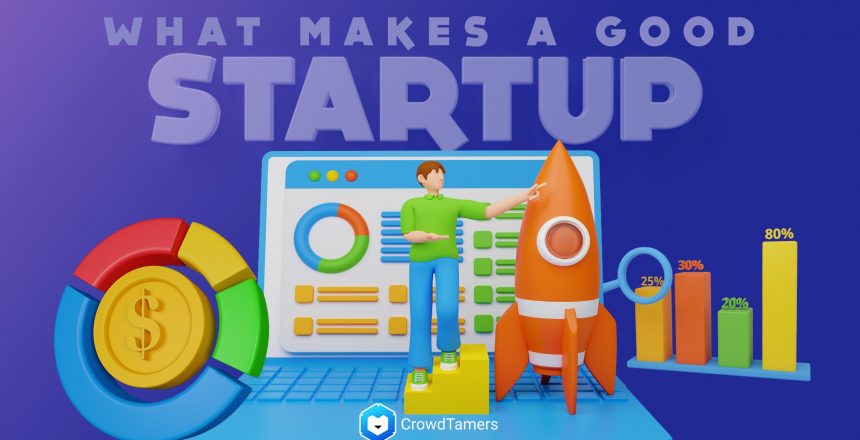I have been known to angel invest in a few companies and am an advisor to a few more. As part of my goal to launch 1,000 startups to $1MM in ARR over the next 6.5 years, I see a lot of startups from the inside. I want to help every startup and founder with time or services from CrowdTamers, or even sometimes money, but there are many startups that don’t have what it takes to be successful at it with my approach.
So with the caveat that your startup might be in a good place even if you don’t fit these qualifications, here’s what a good early stage-startup looks like to me:
You have a product
Whether it’s a prototype made for a hardware startup or a functioning MVP-stage product for a SaaS company, I don’t think you can call yourself an “early-stage startup” if you’re a pre-product. The costs to build and launch MVPs are so minimal these days that virtually anyone with an internet connection and a job can launch the first minimal version of their product for a few dozen or a few hundred dollars. If you don’t even have that much capital to launch a new idea, you’re going to have a very very very hard time getting off the ground in any case.
You have 10 customers
Seth Godin originated the idea that 10 customers who love your product are enough to validate what you’re doing to scale it. When you have even 10 paying customers—whether they’re paying you ten cents or ten grand each—you have a kernel of market validation. Finding those 10 customers means you can probably find 10,000 paying customers if your market is that big.
If you can get 10 customers for your startup you can likely get 10,000 paying customers.
— Andrew Gazdecki (@agazdecki) September 1, 2021
You have a distribution moat
First time founders are obsessed with product.
— Justin Kan (@justinkan) November 7, 2018
Second time founders are obsessed with distribution.
A startup that’s destined to rocket to the moon has to have a distribution channel that is hard for competition to attack. It could be that you’ve made a marketplace play and you’re listed in 20 different major application marketplaces, you’re one of a handful of top-level resellers of a huge platform, you’re a content partner with a roster of similarly aligned companies in parallel spaces, or even something as simple as your founder is well known. Whatever your main channel for user acquisition is, you need to build something resilient enough that someone can’t spend 5x what you’re spending on your acquisition and instantly get all your leads.
You are already building systems that scale
A team of 3 – 5 people can manage all of their systems through email or just talking to each other. The early days of a startup don’t need systems in place to work well: you can run a cowboy deploy straight to production, run sales presentation by the seat of your pants, or launch new features without telling anyone at 10 pm.
But when you get your A round funds wired to you, if you’re not ready to grow from 5 people to 50 in 18 months, your startup will find it has choked to death on all the money it raised, which is the second most common cause of a startup failing.
Variously, if you’re documenting your processes and your culture, making sure that everyone in your early days is cross-trained as much as possible and that you’re able to onboard new team members quickly into your company because you’ve made knowledge transfer fast & simple, you’ll be able to make use of all of the new people you hire as soon as they join you.
Every startup is a complete mess from the inside, but if you’re equipping your team with systems that scale from the beginning, it can at least be a glorious mess where you’re creating new things together more than an awful mess where nothing good ever happens.
You are building more than just a product
Product is only about 20% of the positioning and value prop.
— Trevor Longino (@TrevorLongino) September 2, 2021
The product is a tiny part of what a startup actually sells. What you sell goes beyond the code you shipped or the hardware you delivered. Your customers buy because of your:
- Audience
- Messaging
- Price
- Packaging / distribution
- Product
An excellent early-stage startup doesn’t have to have concrete answers for the above, but it has to be trying to answer those questions. If the founders only care about the product (which is at most 20% of that list above), then the startup can’t grow if any of their competitors tackle the other 80%.
Success isn’t revenue or users at this stage
You don’t need $X MRR or Y users to be a successful seed-stage startup. If you can craft a compelling story to both investors and leads and you have early validation that there’s a big market you could tackle with the tools and team you have in hand, you’re ready to grow, whether you’re bootstrapping, taking VC money, or finding some other path to $1MM+ in ARR.
Have any questions? Think I’m wrong and horrible? Hit me up on Twitter, and let’s chat. 🙂



